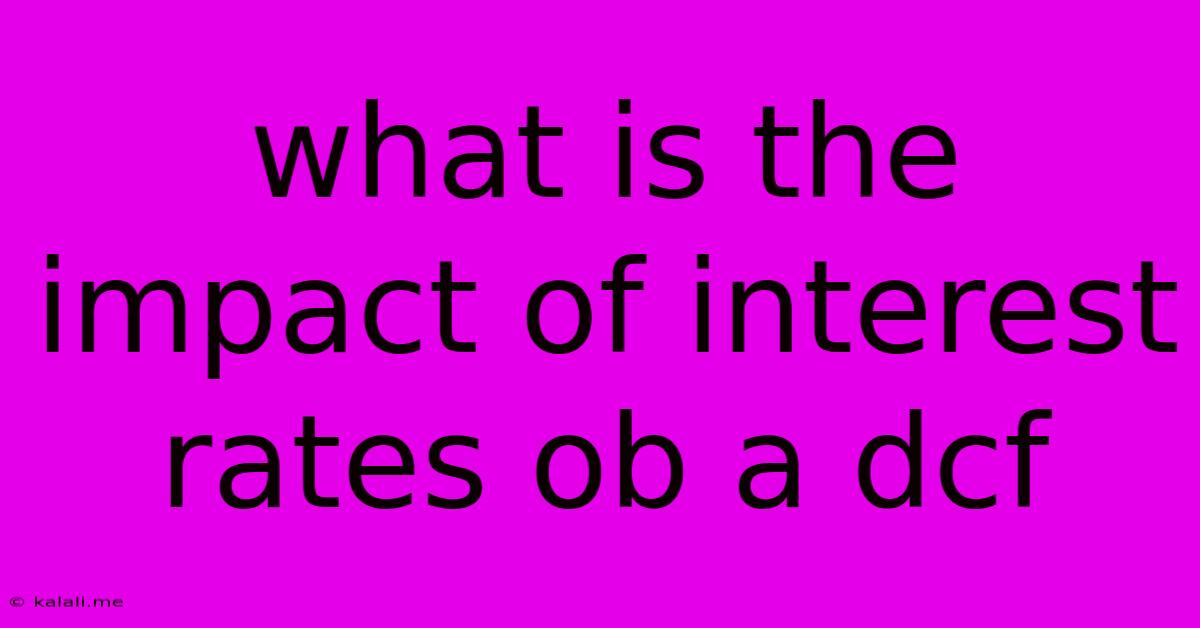What Is The Impact Of Interest Rates Ob A Dcf
Kalali
Jun 07, 2025 · 3 min read

Table of Contents
The Impact of Interest Rates on a Discounted Cash Flow (DCF) Analysis
The Discounted Cash Flow (DCF) analysis is a cornerstone of financial valuation, used to estimate the value of an investment based on its expected future cash flows. A core component of this analysis is the discount rate, which is heavily influenced by prevailing interest rates. Understanding this relationship is crucial for accurate valuation. This article will explore the significant impact interest rates have on DCF calculations and the resulting implications for investment decisions. Understanding this interplay is vital for accurate valuation and informed investment decisions.
What is a Discounted Cash Flow (DCF) Analysis?
A DCF analysis projects a company's future cash flows and discounts them back to their present value using a discount rate. This discount rate reflects the time value of money – the idea that money available today is worth more than the same amount in the future due to its potential earning capacity. The higher the discount rate, the lower the present value of future cash flows.
The Role of the Discount Rate
The discount rate used in a DCF analysis is typically the Weighted Average Cost of Capital (WACC), a blend of the cost of equity and the cost of debt. Both components are significantly influenced by interest rates.
-
Cost of Debt: This directly reflects the interest rates a company pays on its borrowings. Higher interest rates lead to a higher cost of debt, directly increasing the WACC.
-
Cost of Equity: While not directly tied to interest rates, the cost of equity is influenced indirectly. Interest rates impact the risk-free rate of return (often represented by government bond yields), a key input in the Capital Asset Pricing Model (CAPM), a common method for calculating the cost of equity. Higher interest rates generally lead to a higher risk-free rate, and subsequently, a higher cost of equity.
How Interest Rate Changes Affect DCF Valuation
An increase in interest rates will generally lead to:
-
Higher Discount Rate: As explained above, both the cost of debt and cost of equity tend to rise with increasing interest rates, resulting in a higher WACC.
-
Lower Present Value of Future Cash Flows: A higher discount rate reduces the present value of all future cash flows, leading to a lower overall valuation of the investment. This is because future cash flows are discounted more heavily.
Conversely, a decrease in interest rates will generally lead to:
-
Lower Discount Rate: The cost of debt and cost of equity will likely fall, resulting in a lower WACC.
-
Higher Present Value of Future Cash Flows: A lower discount rate increases the present value of future cash flows, leading to a higher overall valuation.
Implications for Investment Decisions
The sensitivity of DCF valuations to interest rate changes highlights the importance of considering interest rate forecasts when making investment decisions. Investors should:
-
Analyze Interest Rate Trends: Monitor economic indicators and central bank policies to anticipate potential interest rate movements.
-
Perform Sensitivity Analysis: Conduct sensitivity analyses to assess the impact of various interest rate scenarios on the DCF valuation. This helps understand the range of possible outcomes and the associated risk.
-
Consider Alternative Valuation Methods: While DCF is a powerful tool, it's crucial to consider other valuation methods alongside it to obtain a more comprehensive view.
Conclusion
Interest rates play a critical role in determining the discount rate used in DCF analysis, significantly impacting the present value of future cash flows and the overall valuation of an investment. Understanding this relationship is paramount for investors and financial analysts to make informed and accurate investment decisions. By analyzing interest rate trends and performing sensitivity analyses, investors can better navigate the uncertainties associated with interest rate fluctuations and make more robust investment choices. Remember, a DCF is only as good as its inputs, and a careful consideration of interest rate impacts is key to its accuracy.
Latest Posts
Latest Posts
-
How Does Reach And A Glaive Work In Dnd 5e
Jun 08, 2025
-
Garage Door Only Closes If I Hold Button Down
Jun 08, 2025
-
Can You Win Uno With A Wild Card
Jun 08, 2025
-
Hampton Bay Ceiling Fan Wiring Diagram
Jun 08, 2025
-
Is Pre Shared Key A Password On Router
Jun 08, 2025
Related Post
Thank you for visiting our website which covers about What Is The Impact Of Interest Rates Ob A Dcf . We hope the information provided has been useful to you. Feel free to contact us if you have any questions or need further assistance. See you next time and don't miss to bookmark.